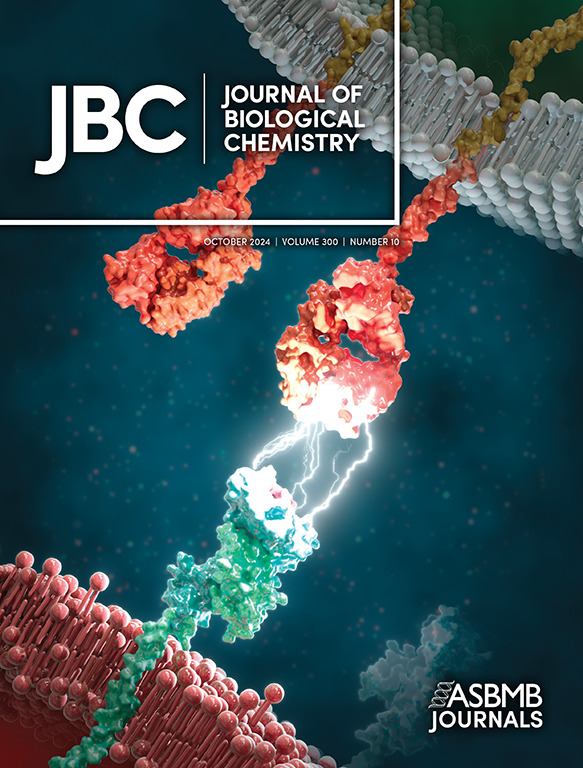Crosstalk between iron and flavins in the opportunistic fungal pathogen Candida albicans.
IF 4
2区 生物学
Q2 BIOCHEMISTRY & MOLECULAR BIOLOGY
引用次数: 0
Abstract
As part of the innate immune response, the host withholds metal micronutrients such as iron (Fe) from invading pathogens. To survive such Fe-limitation, the opportunistic fungal pathogen Candida albicans has evolved elaborate responses to Fe-starvation stress. One such adaptation involves secretion of flavins, yellow isoalloxazine compounds that serve important redox roles in biology. Why the organism secretes flavins during Fe-starvation is not known. Moreover, the exact flavin secreted by the fungus or the effects of Fe-starvation on intracellular flavin pools has not been documented. Major cellular flavins include riboflavin (vitamin B2) and the downstream metabolites and enzyme co-factors FAD and FMN. Of these, our HPLC and mass spectrometry analyses identify riboflavin as the sole flavin secreted by Fe-starved C. albicans. Fe also regulates intracellular pools of flavins. While Fe-replete cells have abundant FMN and FAD with only trace riboflavin, Fe-starvation induces a spike in intracellular riboflavin, whereas FMN and FAD are unaffected. These shifts in riboflavin are dependent on the Fe-sensing transcription factor Sef1. During Fe-starvation, Sef1 induces genes for riboflavin biosynthesis, but not for the conversion of riboflavin to FMN and FAD. Sef1 is also needed to activate riboflavin export. We provide evidence for the first time that extracellular riboflavin can enhance fungal uptake of Fe. Specifically, riboflavin increased C. albicans acquisition of Fe from animal serum, presumably through its redox activity on extracellular Fe. Our observed role of riboflavin on Fe uptake may promote C. albicans fitness in the Fe-limiting environment of the host.机会真菌病原体白色念珠菌中铁与黄素的串扰。
作为先天免疫反应的一部分,宿主阻止入侵病原体的金属微量营养素,如铁(Fe)。为了在这种铁限制下生存,机会性真菌病原体白色念珠菌进化出了对铁饥饿胁迫的复杂反应。其中一种适应涉及黄素的分泌,黄异氧嘧啶化合物在生物学中起着重要的氧化还原作用。为什么生物体在缺铁时分泌黄素尚不清楚。此外,真菌分泌的确切黄素或缺铁对细胞内黄素库的影响尚未有文献记载。主要的细胞黄素包括核黄素(维生素B2)及其下游代谢产物和酶辅因子FAD和FMN。其中,我们的HPLC和质谱分析确定核黄素是缺铁白色念珠菌分泌的唯一黄素。铁也调节细胞内的黄素池。虽然富铁细胞有丰富的FMN和FAD,但只有微量核黄素,缺铁诱导细胞内核黄素峰值,而FMN和FAD不受影响。核黄素的这些变化依赖于铁传感转录因子Sef1。在缺铁过程中,Sef1诱导核黄素生物合成基因,但不诱导核黄素转化为FMN和FAD的基因。Sef1也需要激活核黄素的输出。我们首次提供了细胞外核黄素可以增强真菌对铁的吸收的证据。具体来说,核黄素增加了白色念珠菌从动物血清中获得铁,可能是通过其对细胞外铁的氧化还原活性。我们观察到核黄素对铁摄取的作用可能促进白色念珠菌在宿主限铁环境中的适应性。
本文章由计算机程序翻译,如有差异,请以英文原文为准。
求助全文
约1分钟内获得全文
求助全文
来源期刊

Journal of Biological Chemistry
Biochemistry, Genetics and Molecular Biology-Biochemistry
自引率
4.20%
发文量
1233
期刊介绍:
The Journal of Biological Chemistry welcomes high-quality science that seeks to elucidate the molecular and cellular basis of biological processes. Papers published in JBC can therefore fall under the umbrellas of not only biological chemistry, chemical biology, or biochemistry, but also allied disciplines such as biophysics, systems biology, RNA biology, immunology, microbiology, neurobiology, epigenetics, computational biology, ’omics, and many more. The outcome of our focus on papers that contribute novel and important mechanistic insights, rather than on a particular topic area, is that JBC is truly a melting pot for scientists across disciplines. In addition, JBC welcomes papers that describe methods that will help scientists push their biochemical inquiries forward and resources that will be of use to the research community.
 求助内容:
求助内容: 应助结果提醒方式:
应助结果提醒方式:


